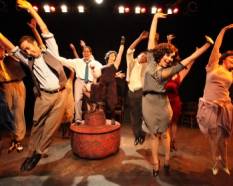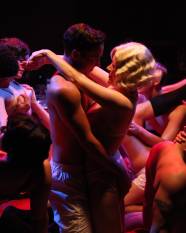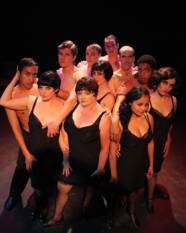
Andrew Lippa’s The Wild Party is a tough show to nail. In fact, one of the few times I’ve left a production at intermission was a well-intentioned but mostly disastrous attempt at meeting TWP’s many challenges. That’s why Theatre Out’s intimate staging down Santa Ana way comes as such a thrilling surprise, one which marks director-choreographer Frankie Marrone as One To Watch and spotlights a revelatory performance by a never better Andrea Dennison-Laufer.
Musical theater aficionados know that there are two song-and-dance versions of Joseph Moncure March’s 1928 epic poem, the 2000 Broadway show with music and lyrics by Michael John LaChiusa, and the 2000 off-Broadway version with music and lyrics by Lippa. Both shows deal with the same love quadrangle and both begin with a song which features the poem’s opening lines, “Queenie was a blonde and her age stood still, and she danced twice a day in vaudeville. Queenie was a blonde, and if looks could kill, she would kill twice a day in vaudeville.”
The basic plot of both is simple. Platinum blonde entertainer Queenie (Dennison-Laufer) and her abusive lover of seven years, Burrs (Joaquin Nunez), throw a party for their friends: lesbian Madelaine True (Janet McGregor), pugilist Eddie (Josh Holman), “sweet dancer” Jackie (Sergio Mitre), pianist-composers Oscar and Phil D’Armano (Jared Ryan Kaitz and Dustin Thompson), hooker Dolores (Nicole Roca), “looker” Mae (Colleen Wilson), and Nadine (Katherine Gutierrez)—a minor. Things start out wild and get even wilder when a firecracker named Kate (Katy Harvey) arrives with her latest flame, Black (Eric Ronquillo). Black and Queenie hit it off—with tragic consequences.
LaChiusa’s version fleshes out the stories of the dozen or so party guests and features a 1920s flavored (and to many ears discordant) score, while Lippa’s Wild Party focuses mainly on the mismatched pairs of lovers and includes many showstoppers (“Let’s Raise The Roof,” “A Wild Wild Party,” etc.) with a more contemporary feel.
Marrone’s inspired direction impresses from the get-go, red velvet curtains (installed at the Empire Theatre specifically for this show) parting just enough to spotlight Dennison-Laufer, striking in platinum blonde bob and satiny gown. Soon, the drapes have parted completely, Queenie surrounded by shirtless male cast members who confirm at once that a) Marrone’s choreography will be no cakewalk and b) they are fully up to it. Before long the boys are joined by the equally nimble female ensemble dressed in skimpy black lace for an opening sequence that builds and builds in energy and excitement.
The director finds many imaginative ways to use this Greek chorus of voices in Queenie’s head, handing her props and bowing to her when she is introduced to us as Queen(ie). One particularly inspired Marrone moment has a female ensemble member whisper into Queenie’s ear the word that will ignite the evening’s passions: “Party!”
Soon the guests have arrived in 1920s costumes and the Latin-themed “Let’s Raise The Roof” gets them dancing to some truly exciting footwork. Other production numbers spotlighting Marrone’s choreography and the cast’s dance skills include the frantic “The Juggernaut,” the finger-snapping “A Wild Wild Party,” and the frenetic “Let Me Drown.” And if a lesbian partygoer and a pair of gay “brothers” aren’t enough LGBTness for picky gay theater queens, then “Come With Me,” the show’s trisexual orgy sequence will surely prove otherwise.
Unlike LaChiusa’s The Wild Party, Lippa’s version gives only three of the peripheral characters their own songs. Madelaine takes the spotlight for the racy, hilarious “An Old Fashioned Love Story.” (“I need a good-natured, old-fashioned lesbian love story, the kind of tale my mama used to tell.”), and McGregor sells it with bawdy good humor like nobody’s business. Muscular musical theater newcomer Holman and showstopper Wilson as mountainous Eddie and Betty Boopesque Mae duet “Two Of A Kind” about their highly mismatched coupledom, and get deserved cheers. (“She’s a one-two punch, he’s a catered lunch. She’s a melon, I’m the rind. He’s one of the good guys, and we’re two of a kind.”)
Most of the evening belongs to its four stars.
Nunez is a powerhouse Burrs, a short-statured big-shouldered bull of a man with great big vocal chops to match, precisely the kind that might attract a vaudeville blonde like Queenie. Ronquillo radiates leading man charisma as Black, Burrs’ matinee idol-handsome opposite, and precisely the kind of pure-hearted man that a beaten-down Queenie might find irresistible. Think a young George Clooney (with terrific pipes) opposite a young James Gandolfini and you’ve got the Ronquillo-Nunez picture.
Still, it’s the women whom Lippa has given the two prime roles at the party, and here too Theatre Out has struck gold. Dennison-Laufer is the company’s unofficial resident diva, and here she follows excellent work in Tick, Tick…Boom!, Zanna, Don’t!, Boys Will Be Boys, and A Queer Carol with a performance that outdoes them all, and then some. Fully up to the singing demands Lippa’s high notes place on Queenie, a stellar Dennison-Laufer acts with supreme confidence and sex appeal to match her vocal prowess. Ball-of-fire Harvey tops her standout work in Maverick Theatre’s recent The Wedding Singer with a take-no-prisoners star turn as Kate, a petite force of nature with power pipes and unrestrained sexual oomph.
Among supporting players, Kaitz and Thompson are sassy delights, James Oronoz (Jack) shows off a terrific high tenor belt, and Mitre dances “Jackie’s Last Dance” with beauty and grace (though why tongueless [i.e. mute] Jackie been directed to sing along in group numbers is anyone’s guess).
Completing the first-class ensemble are David Miller as Sam, Nicki Peek as Peggy and Alissa Sanchez as Roberta, with a prerecorded Justin Scott Eaton as The Neighbor.
Musical director Stephen Amundson has the cast harmonizing to perfection to T.J. Dawson and 3D Theatricals’ orchestral tracks even as they execute Maronne’s high-powered dance steps.
Theatre Out’s Empire Theatre proves the perfect venue for The Wild Party, its wide stage offering ample room for big-cast dance numbers, allowing the partygoers to be virtually ever-present, whether spying on the action or canoodling in some nook or cranny, and permitting scenes to alternate left, center, or right so that no seat assignment gets a raw deal. The audience’s proximity to the stage gives this Wild Party an in-your-face pow that proves a plus as well.
Scenic designer David C. Carneval’s simple but effective black-box set makes great use of the Empire’s ample stage area. Carnevale’s and Joey Baital’s period costumes are about as splashy and spiffy as a theatergoer can expect from a tight-budgeted production. Christina L. Munich’s lighting is the busy designer’s accustomed fine work. Sound mixing of unamped voices and prerecorded tracks is nigh-on perfect.
Chelsea Mundy is stage manager, Sanchez assistant choreographer for “Jackie’s Last Dance” and “Come With Me,” and Roca assistant choreographer for “Two Of A Kind.”
Producing quality intimate theater presents a particular challenge in Orange County. Since AEA’s 99-seat-plan is applicable only inside Los Angeles County, small OC theaters are forbidden to hire the Equity performers who make up a large percentage of L.A. casts. Theatre Out productions like The Busy World Is Hushed, Tick, Tick…Boom!, and Boys Will Be Boys have proven Orange County’s LGBT theater up to this challenge, and The Wild Party may well be Theatre Out’s finest production to date. This is one case when audience cheers after virtually every number are more than justified.
Theatre Out, The Empire Theatre, 202 N. Broadway, Santa Ana.
www.theatreout.com
–Steven Stanley
June 19, 2011
Photos: Stephen Rack





 Since 2007, Steven Stanley's StageSceneLA.com has spotlighted the best in Southern California theater via reviews, interviews, and its annual StageSceneLA Scenies.
Since 2007, Steven Stanley's StageSceneLA.com has spotlighted the best in Southern California theater via reviews, interviews, and its annual StageSceneLA Scenies.







 COPYRIGHT 2024 STEVEN STANLEY :: DESIGN BY
COPYRIGHT 2024 STEVEN STANLEY :: DESIGN BY